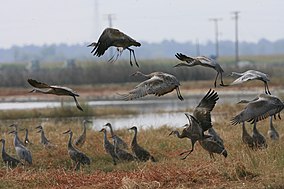Merced National Wildlife Refuge
| Merced National Wildlife Refuge | |
|---|---|
|
IUCN category IV (habitat/species management area)
|
|

A flock of sandhill cranes landing
|
|
|
Map of the United States
|
|
| Location | Merced County, California, United States |
| Nearest city | Merced, California |
| Coordinates | 37°10′45″N 120°38′12″W / 37.17911°N 120.63658°WCoordinates: 37°10′45″N 120°38′12″W / 37.17911°N 120.63658°W |
| Area | 10,262 acres (41.53 km2) |
| Established | 1951 |
| Governing body | U.S. Fish and Wildlife Service |
| Website | Merced National Wildlife Refuge |
The Merced National Wildlife Refuge encompasses 10,262 acres (41.53 km2) of wetlands, native grasslands, vernal pools, and riparian areas in California. It was established in 1951 under the Lea Act to attract wintering waterfowl from adjacent farmland where their foraging was causing crop damage. In the last few decades, changes in agricultural practices and refuge management have reduced these wildlife/crop issues.
The refuge plays host to the largest wintering populations of lesser sandhill cranes and Ross's geese within the Pacific Flyway. Each autumn over 20,000 cranes and 60,000 arctic nesting geese terminate their annual migrations from Alaska and Canada to make the refuge home for six months. Here they mingle with thousands of other visiting waterfowl, waterbirds and shorebirds making the refuge a true winter phenomenon.
The refuge also provides important breeding habitat for Swainson's hawks, tri-colored blackbirds, marsh wrens, mallards, gadwall, cinnamon teal, and burrowing owls. Tri-colored blackbirds, a colonial-nesting songbird, breed in colonies of over 25,000 pairs. Coyotes, ground squirrels, desert cottontail rabbits, beaver, and long-tailed weasels can also be seen year-round.
...
Wikipedia

